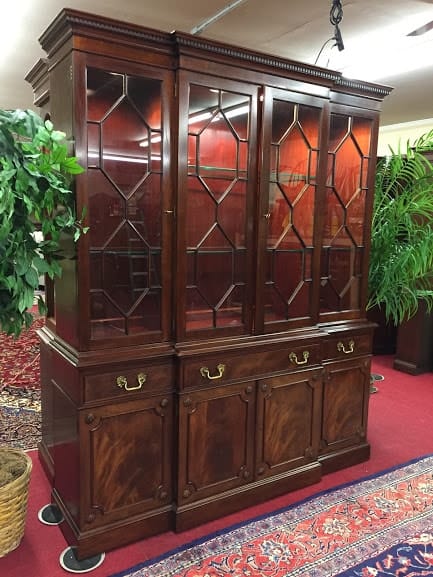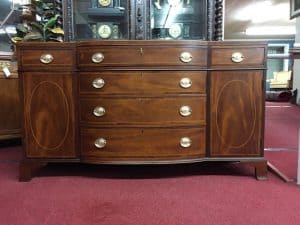
Kittinger Furniture Company holds a significant place in American furniture history, known for its craftsmanship, quality, and contributions to traditional furniture design. Here’s an overview of the history of Kittinger Furniture:
Founding: Kittinger Furniture Company was founded in 1866 by George L. Kittinger in Buffalo, New York. Originally a manufacturer of fine cabinetry and casegoods, the company quickly gained a reputation for its high-quality craftsmanship and attention to detail.
Early Years: In its early years, Kittinger produced furniture in traditional styles such as Chippendale, Queen Anne, and Hepplewhite, catering to the tastes of affluent clients seeking finely crafted pieces for their homes.
Expansion and Innovation: Over the years, Kittinger expanded its product line and adopted innovative manufacturing techniques to meet the growing demand for its furniture. The company’s commitment to quality and craftsmanship remained central to its ethos, earning it a loyal customer base and prestigious commissions.
Colonial Williamsburg Partnership: In the mid-20th century, Kittinger Furniture entered into a partnership with Colonial Williamsburg, a historic preservation and restoration project in Virginia. This collaboration led to the creation of the Colonial Williamsburg Reproductions collection, which featured meticulously crafted replicas of 18th-century American furniture.
Authentic Reproductions: Kittinger’s collaboration with Colonial Williamsburg was groundbreaking in its commitment to producing authentic reproductions of historic furniture pieces. The company’s craftsmen meticulously studied original pieces, using traditional woodworking techniques and materials to recreate them with unparalleled accuracy.
Prestigious Commissions: Kittinger Furniture gained recognition for its craftsmanship and received prestigious commissions from prominent individuals and institutions. Its furniture graced the White House, executive offices, embassies, and distinguished residences across the United States and abroad.
Legacy and Influence: Kittinger Furniture’s legacy extends beyond its craftsmanship and product offerings. The company played a significant role in preserving and promoting traditional American furniture styles, contributing to the revival of interest in colonial and early American design aesthetics.
Acquisitions and Changes: In the late 20th century, Kittinger Furniture underwent changes in ownership and management, leading to shifts in its operations and product focus. The company continued to produce high-quality furniture, but its output and prominence in the industry evolved over time.
Collectibility: Today, vintage Kittinger Furniture pieces are highly sought after by collectors and enthusiasts of traditional American furniture. The company’s legacy of craftsmanship, quality, and historical significance has ensured the enduring appeal and collectibility of its furniture.
Continued Presence: While Kittinger Furniture may no longer operate under its original name or ownership, its impact on the furniture industry and its contributions to American design and craftsmanship continue to be celebrated and remembered by collectors, historians, and aficionados of fine furniture.
In summary, Kittinger Furniture Company holds a distinguished place in American furniture history, known for its craftsmanship, innovation, and commitment to traditional design aesthetics. Its collaboration with Colonial Williamsburg and its legacy of producing authentic reproductions of historic furniture have left an indelible mark on the furniture industry and the appreciation of American craftsmanship.
Kittinger Furniture company
Kittinger Furniture excels at the artistry of furniture making. If you, like us, have ever dabbled in refinishing vintage furniture, or painting a piece, prepare to feel really inadequate about your work. 
You know that moment, after you have sanded and stained and waxed. Maybe after a weekend in your garage or so you stand back to admire your work. Here comes the hard cold smack of truth.:
You are a kindergartner to these guys.
Kittinger Furniture History
First let me say, Kittinger furnishes the White House, and the Senate, and lots of foreign embassies. And lots of heads of states private homes and offices.
This is serious office dining and reception room furniture.
If you thought apprenticeship died with dental work in the middle ages, you are mistaken. People that work in the Kittinger factory in Buffalo New York are people with years of experience under their belt. One single family has produced five generations of craftsman. Their experience totals over 175 years of craftsmanship.
That is some furniture-making resume.
Kittinger
Reading Kittinger’s website really made me recognize what hand made artistry furniture is all about. Think about the chair you are sitting in right now. Most likely it is something with legs.
If it is a Kittinger chair, each leg was cut into a solid column from the finest Brazilian Mahogany (known sometimes as Prime Mahogany) and turned on a lathe. But then it goes to two hands. The claw foot design was meticulously sketched onto a blue print (using of course tons of research of 18th century design) and followed by a craftsman with a spindle carver. Then this leg goes into the hand of a master carver who adds the finishing touches.
It may take two days for this leg to be completed… and we are just talking about ONE leg on ONE piece of furniture.
Craftsmanship
You can imagine, the rest of any piece of furniture, goes through many hands and days of work before final inspection at Kittinger. The finish alone (remember that old dresser you stripped and restained in a weekend) can include 50 hours of hand work and WAIT for it, three weeks to finish.
This is not box store furniture you put together with an allen wrench people, this is Craftsmanship with a capital “C.”
Did we mention the President sits at it everyday?
American Furniture
There are tons of exceptional details one can appreciate about Kittinger Furniture. When we are lucky enough to find a piece by Kittinger, we ooh and aww at it for usually about an hour (And I don’t think we are alone). The veneers that this company has used are simply breath-taking. Dramatic cathedral grains of mahogany and swirls in the wood make us believe in a higher power, this simply can not be true nature!
Most tables have a complicated and multi-level of banding on the edge. Most cabinets and hutches have fitted glass in each pane. It simply has a great weight and feel to it. The drawers slide perfectly and everything functions as if it just came out of the cabinetmakers shop. This is not simply vintage furniture, this is art, this is craft, this is American furniture at it’s best.
And America chooses Kittinger. We think you should too. 🙂
Check out Kittinger Furniture to view our Kittinger furniture for sale.
Thank you for inviting us into your vintage style home!
Rachel La Bohème
Kittinger Dresser
